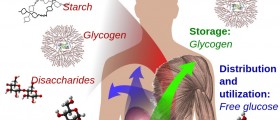
Metabolism is the process of breaking down proteins, carbohydrates, and fats in order to obtain the energy body needs to function and maintain life. Metabolism is divided in two categories: catabolism and anabolism.
Catabolism is a set of chemical reactions that break down molecules into smaller elements and release energy. Anabolism, however, uses energy to construct molecules from smaller elements.
Metabolic reactions are organized into pathways where chemicals are being transformed into another chemical by a string of enzymes. Enzymes are proteins that increase the rate of chemical reactions, and they are crucial to metabolism. Enzymes actually catalyze chemical reactions, and allow different elements to interfere. Metabolism determines which substances will be nutritious and which of them are going to be poisonous to organism. The metabolic rate, or speed, weights how much of food will an organism need.
Key biochemical
The function of catabolic reactions is to provide energy for anabolic reactions. Organisms are usually classified by their primary nutritional groups based on their sources of energy and carbon. Therefore, catabolic reactions vary in different sets of organisms. Still, all forms of metabolism depend on reactions based on transferring electrons from organic molecules, water, ammonia, hydrogen sulfide or ferrous ions to acceptor molecules such as oxygen nitrate or sulfate. Those complex organic molecules are being break into simpler molecules, in animals.Organic structures in animals, plants and microbes are typically made of three basic groups of molecules: amino acids, carbohydrates and lipids. Metabolic reactions are breaking down these molecules and use them as energy source as well as making those molecules when building the cells and tissues. Many vital biochemical can be joined together to make polymers such as DNA and proteins, these are known as essential molecules.
Structure of the catabolic reactions
Large organic molecules (proteins, polysaccharides or lipids) are processed into their minor components outside cells. Secondly, these minor molecules are absorbed by cells and transformed to even smaller molecules, usually acetyl coenzyme A (acetyl-CoA), which discharges a quantity of energy. Lastly, the acetyl group on the CoA is oxidized to water and carbon dioxide in the citric acid cycle and electron transport chain, so that the energy that is stored, by reducing the coenzyme nicotinamide adenine dinucleotide (NAD+) into NADH, is released.
DigestionMacromolecules can’t be rapidly absorbed by cells and they need to be resolved into smaller units before they can be used in cell metabolism. Enzymes serve to digest these macromolecules. In microbes and animals situation is somewhat different. Microbes simply secrete digestive enzymes into their environment while animals produce enzymes from cells in their guts.
A healthy metabolism is essential to preserve vital functions of the body, repair damage, heal injury, and help to rid of harmful toxins. Fundamentally, it is the necessary process for staying alive and maintaining a healthy, functioning organism.

















Your thoughts on this
Loading...